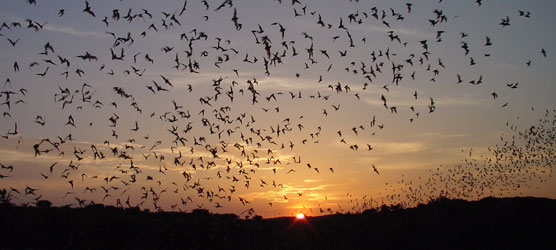|
The Mexican Free-Tailed Bat (Tadarida brasiliensis)- also known as the Guano BatDespite its name, a Mexican free-tailed bat, can be found darting about in places from Argentina to the north American states of Oregon, Nebraska and Ohio. This is its range and some members of this species spend their winters in central and south America and then migrate further north during the spring. They're also found in many parts of the Caribbean. 
Some of these migrating bats make up one of the world's best bat spectacles, drawing visitors from all over the world! This beautiful photo (from Wikimedia Commons) is of one such spectacle at the Carlsbad Caverns in New Mexico. And there's also some footage of the bats in Austin Texas , emerging from their Congress Avenue bridge roost, if you'd like to find out more about this. They're not the biggest of bats (an adult can grow to be around 10cm/4 inches in length), but when it comes to speed, they're the cheetahs of the chiroptera world. These agile bats can fly at speeds of 60 mph (97 km/h). All this speedy flight is powered by an energy-rich diet of insects, some of which are agricultural pests like the cotton bollworm moth. A steady supply of insects is particularly important for the pregnant bats that form massive maternity roosts when they arrive in North America during spring time. Each pregnant female will usually give birth to one baby bat , known as a pup. In Spanish, the name for a Mexican free-tailed bat is murciélago guanero, which you might have guessed means guano bat. Colonies of this species produce impressive amounts of bat poop , a prized fertilizer and a source of one of the main components of gunpowder. However, in the past, collection of it has caused disturbance of their cave roosts, which can have a very negative effect on cave ecosystems. Bat poop isn't such big business nowadays but due to fears of bats and rabies and mining, roost disturbance does still happen. While these are concerns, they're not seen as serious threats at the moment by the International Union for Conservation of Nature (IUCN). The IUCN lists the Mexican free-tailed bat conservation status as being of least concern. Fingers-crossed, it will stay this way for years to come for this interesting bat species. Return from The Mexican Free-Tailed Bat to Chiroptera, The Order Of Bats
|






